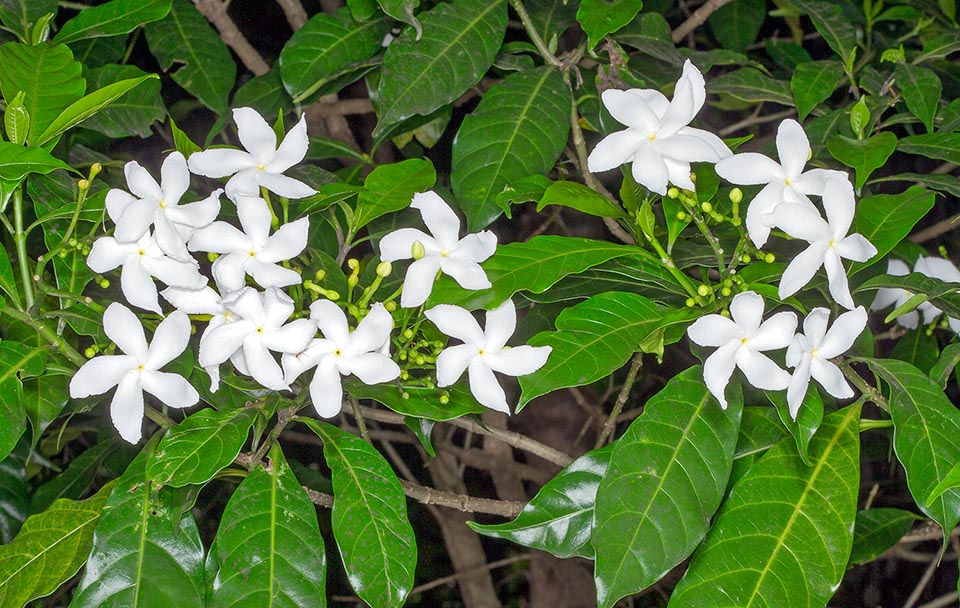Family : Apocynaceae

Text © Pietro Puccio

English translation by Mario Beltramini
The species is native to Arunachal Pradesh, Assam, Bangladesh, Bhutan, Cambodia, China (Chongqing, Guizhou, Hubei, Sichuan and Yunnan), Darjeeling, Himachal Pradesh, India, Jammu-Kashmir, Laos, Myanmar, Nepal, Sikkim, Thailand, Uttaranchal and Vietnam where it lives in the humid forests up to about 1500 m of altitude.
The genus is honoured to the German physician and botanist Jakob Theodor Müller von Bergzabern (ca. 1520-1590), Tabernaemontanus is the Latinized name of Bergzabern; the specific name is the perfect participle of the Latin verb “divarico” = to open wide, to diverge, with refrence to the branches.
Common names: butterfly gardenia, crape gardenia, crape jasmine, crepe jasmine, east Indian rose-bay, paper gardenia, pinwheel flower (English); tagar (bengali); gou ya hua (Chinese); candni, tagar (Hindi); kottubale, nandi battalu (Kannada); nantyarvattam (Malayalam); ananta (Marathi); nandivrksah (Sanskrit); rosa de hielo (Spanish); atukkunatyarvattai (Tamil); gandhitagarapu (Telugu).
The Tabernaemontana divaricata (L.) R.Br. ex Roem. & Schult. (1819) is a shrub or small evergreen tree, up to about 4 m tall, with dichotomous ramifications and milky sap. The leaves, on a 0,4-1 cm long petiole, are opposite, simple, oblong-lanceolate with long pointed apex and entire margin slightly waved, 7-15 cm long and 2-4 cm broad, of intense green colour and glossy above, opaque below and prominent veins. The inflorescences, at the axil of the upper bifurcations of the branches, are cymes carrying 2-10 flowers of 3-5 cm of diameter that smell at night. Calyx with ovate sepals, hypocraterimorphous corolla (with lobes spread perpendicularly to a long and thin tube) with greenish tube 1,5-2,5 cm long, oblong-ovate lobes, 1,5-2,5 cm long and about 1 cm broad, of white colour with yellow centre, waxy. The fruits are oblong follicles in couple with a pointed curved extension, of 4-7 cm of length and of 0,8-1,5 cm of diameter, containing several seeds covered by red aril.
It reproduces by seed, previously immersed in water for two days, in draining organic loam maintained humid at the temperature of 24-26 °C, with germination times of 1-2 months; it propagates also by cutting with bottom heat in spring. Thanks to the luxuriant foliage and the blooming almost continuous with pleasant smell in the evening hours, the Tabernaemontana divaricata is amply cultivated in the gardens of the tropical and subtropical climate zones and marginally in the temperate-warm ones, where it can resist without damages to temperatures around the -2 °C for very short time, slightly lower values may destroy the aerial part, but with regrowth from the base in spring. Besides the species are very appreciated the varieties with semi-double and double flower, among which one of the most diffused is the ‘Flore Pleno’.

Native to the tropical reagions of South-East Asia, Tabernaemontana divaricata is an about 4 m evergreen, with dichotomous ramifications and milky sap. 3-5 cm of diameter flowers. Smelling by night, united in rich inflorescences at the axil of the branches upper bifurcations. All parts of the plant are toxic. In the past the latex was used to poison the arrows. Traditional medicinal virtues of roots, leaves, flowers and latex are nowadays screened by the official pharmacopoeia © Giuseppe Mazza
All parts of the plant are toxic due to the abundant presence of indolic alkaloids, in the past the latex was utilized for poisoning the arrows. Roots, leaves, flowers and latex are utilized since remote times in the traditional medicine, in particular in the Indian one, for several pathologies; the numerous bioactive compounds present are considered of potential interest for the official pharmacopoeia and object of studies.
Synonyms: Nerium divaricatum L. (1753); Jasminum zeylanicum Burm.f. (1768); Nyctanthes acuminata Burm.f. (1768); Nerium coronarium Jacq. (1787); Tabernaemontana discolor Sw. (1788); Vinca alba Noronha (1790); Tabernaemontana coronaria (Jacq.) Willd. (1809); Tabernaemontana citrifolia Lunan (1814); Tabernaemontana recurva Roxb. (1814); Reichardia grandiflora Dennst. (1818); Reichardia jasminoides Dennst. (1818); Tabernaemontana indica Willd. ex Roem. & Schult. (1819); Tabernaemontana gratissima Lindl. (1827); Tabernaemontana recurva Roxb. ex Lindl. (1827); Tabernaemontana coronaria var. plena Roxb. ex Voigt (1845); Tabernaemontana lurida Van Heurck & Müll.Arg. (1871); Taberna discolor (Sw.) Miers (1878); Kopsia cochinchinensis Kuntze (1891); Ervatamia coronaria (Jacq.) Stapf (1902); Ervatamia recurva (Roxb. ex Lindl.) Lace (1913); Ervatamia divaricata (L.) Burkill (1925); Tabernaemontana siamensis Warb. ex Pit. (1933); Testudipes recurva (Roxb. ex Lindl.) Markgr. (1935); Ervatamia siamensis (Warb. ex Pit.) Kerr (1939); Ervatamia flabelliformis Tsiang (1963); Tabernaemontana flabelliformis (Tsiang) P.T.Li (1986); Ervatamia divaricata var. plena (Roxb. ex Voigt) M.R.Almeida (2001).
→ To appreciate the biodiversity within the APOCYNACEAE family please click here.
